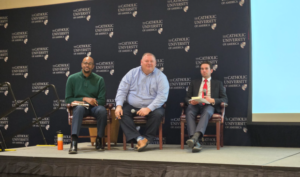The Turkey-Syria Crisis

By Claire Prudhomme
Vice President Mike Pence and Turkish President Recep Tayyip Erdogan met and called for a 120-hour cease-fire on the Turkey-Syrian border this past Thursday.
The Syrian Civil War has caused a target to be placed on the Kurds from the Turkish government. In the Syrian dictatorship’s fight for power, they have seen no error in the mass violence put on their civilians.
According to Amnesty International, more than 30,000 civilians have been killed in the Civil War and hundreds of thousands of refugees have fled the country. Over half of Syria’s pre-war population has been killed or forced to flee the country. Turkey has been involved and intervening in the civil war since it started.
In 2011 Turkey trained defectors of the Syrian Army and, in 2012, began to supply and train the Free Syrian Army. Violent tensions began after Syria shot down a Turkish fighter jet in June, 2012. Four years later in August 2016, Turkey officially declared direct military intervention into Syria, but put most of its focus on the Kurds. Turkey has become increasingly hostile so much to a point where Human Rights Groups like the Syrian Observatory for Human Rights have called attention to their behaviors.
In the agreement made last Thursday, Turkey’s Operation Peace Spring was put on pause so the Kurdish forces could go back into the safe zone on the Turkish-Syrian border. The deal stated that the military operation would end entirely after the Kurds withdrew.
According to CNN, as of Tuesday, October 22nd, the agreement now states that Russia and Turkey are putting shared patrols along the Turkish and Syrian border for the next six days. It now demands that the Syrian Kurds withdraw any form of violent means, whether it be fighters or weapons, even though they are in a safe zone 20 miles away.
The agreement also detailed that the Russian military police and the Turkish border guards will enter the Syrian side of the Syrian-Turkish border from noon Wednesday and, over the following 150 hours. They will remove weapons and the YPG, a primarily Kurdish group allied with the Syrian Democratic Forces, as far as 18 miles into the safe zone.
After a 150-hour time period concludes, they will begin patrols next Tuesday along the line established.








